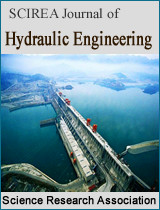Optimal design of Sewer network using Cellular Automata
DOI: 411 Downloads 9607 Views
Author(s)
Abstract
In this paper, the General Cellular Automata (GCA) method is proposed for the optimal design of sewer network problems with the fixed layout. The network nodes and upstream and downstream pipe cover depths are considered as CA cells and cell states, respectively, and the links around each cell are taken into account as neighborhoods. The updating rule is derived mathematically from the original objective function of the problem. The proposed method is a general and flexible method for optimization of sewer networks as it can be used to optimally design both gravity and pumped network due to the use of pipe nodal cover depths as decision variables. The proposed method is tested against three gravitational sewer networks with different sizes and the comparison of results with other methods such as Cellular Automata, and Ant Colony Optimization Algorithm show the efficiency and effectiveness of the proposed method.
Keywords
Pumped Sewer Network, Cellular Automata, Optimization methods
Cite this paper
M. ROHANI, M. H. AFSHAR,
Optimal design of Sewer network using Cellular Automata
, SCIREA Journal of Hydraulic Engineering .
Volume 1, Issue 1, October 2016 | PP. 1-17.
References
| [ 1 ] | M.H., Afshar, 2010, “A parameter free Continuous Ant Colony Optimization Algorithm for the optimal design of storm sewer networks: Constrained and unconstrained approach”, Advances in Engineering Software, 41(2), pp. 188–195. |
| [ 2 ] | M.H., Afshar, M., Shahidi, M., Rohani, M., Sargolzaei, 2011, “Application of cellular automata to sewer network optimization problems”, Scientia Iranica A, 18 (3), pp. 304–312. |
| [ 3 ] | M.H., Afshar, M., Rohani, 2012, “Optimal design of sewer networks using cellular automata-based hybrid methods: Discrete and continuous approaches”, Engineering Optimization, 44(1), pp. 1-22. |
| [ 4 ] | J.S., Dajani, R.S., Gemmell, 1971, “Economics of wastewater collection networks”, Civil Eng. Res. Rep. 43, Water Resour. Center, Univ. of Ill. At Urbana-Champaign, Urbana. |
| [ 5 ] | S., Froise, S.J., Burges, 1978, “Least-cost design of urban drainage networks”, J. Water Resources Planning and Management Division, ASCE, 104(1), pp. 75-92. |
| [ 6 ] | Y., Guo, G.A., Walters, S.T., Khu, E., Keedwell, 2007a, “A novel cellular automata based approach to storm sewer design”, Engineering Optimization, 39 (3), pp. 345-364. |
| [ 7 ] | Y., Guo, E.C., Keedwell, G.A., Walters, S.T., Khu, 2007b, “Hybridizing Cellular Automata Principles and NSGAII for Multi-objective Design of Urban Water Networks”, Evolutionary Multi-Criterion Optimization, pp. 546-559. |
| [ 8 ] | A., Haghighi, A.E., Bakhshipour, 2012, “Optimization of sewer networks using an adaptive genetic algorithm”, Water Resources Management, 26(12), pp. 3441–3456. |
| [ 9 ] | E., Keedwell, S.T., Khu, 2005, “Using cellular automata to seed genetic algorithms for water distribution network design problems”, Engineering Applications of Artificial Intelligence, 18(4), pp. 461-472. |
| [ 10 ] | E., Keedwell, S.T., Khu, 2006a, “Novel cellular automata approach to optimal water distribution network design”, Journal of Computing in Civil Engineering, 20(1), pp. 49–56. |
| [ 11 ] | E., Keedwell, S.T., Khu, 2006b, “A novel evolutionary meta-heuristic for the multi-objective optimization of real-world water distribution networks” Engineering Optimization, 38(3), pp. 319–333. |
| [ 12 ] | V.S., Kulkarni, P., Khanna, 1985, “Pumped wastewater collection systems optimization”, J Environ Eng, ASCE, 111(5), pp. 589–601. |
| [ 13 ] | R., Moeini, M.H., Afshar, 2012a, “Layout and size optimization of sanitary sewer network using intelligent ants”, Advances in Engineering Software, 51, pp. 49–61. |
| [ 14 ] | R., Moeini, M.H., Afshar, 2012b, “Constrained Ant Colony Optimisation Algorithm for the layout and size optimisation of sanitary sewer networks”, Urban Water Journal, pp. 1–20. |
| [ 15 ] | T.C., Pan, J.J., Kao, 2009, “GA-QP model to optimize sewer system design”, Journal of Environmental Engineering, 135 (1), pp. 17–24. |
| [ 16 ] | A., Palumbo, L., Cimorelli, C., Covelli, L., Cozzolino, C., Mucherino, D., Pianese, 2014, “Optimal design of urban drainage networks”, Civil Engineering and Environmental Systems, 31(1), pp. 79–96. |
| [ 17 ] | R.K., Price, 1978, “Design of storm water sewers for minimum construction cost”, In Proc. 1st International Conference on Urban Strom Drainage, Southampton, United Kingdom, pp. 636-647. |
| [ 18 ] | M., Rohani, M.H., Afshar, 2014, “Sewer Networks Optimization Using Cellular Automata”, Studies in Engineering and Technology, 1 (1), pp. 1-12. |
| [ 19 ] | B.C., Yen, S.T., Cheng, B.H., Jun, M.L., Voohees, H.G., Wenzel, 1984, “Illinois least cost sewer system design model”, User’s guide, Department of Civil Engineering, University of Texas at Austin. |
| [ 20 ] | S.F., Yeh, C.W., Chu, Y.J., Chang, M.D., Lin, 2011, “Applying tabu search and simulated annealing to the optimal design of sewer networks”, Engineering Optimization, 43 (2), pp. 159–174. |

